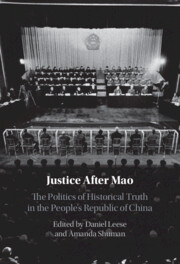Book contents
- Justice After Mao
- Justice After Mao
- Copyright page
- Contents
- Figures
- Tables
- Contributors
- Acknowledgments
- Introduction
- Part I Property
- 1 Between Revolution and Law
- 2 What Right to Property When Rebellion Is Justified?
- 3 The Pursuit of Transitional Justice from Below
- Part II The Mechanics of Rehabilitation
- Part III The Politics of Truth
- Part IV Memory
- Afterword
- Appendix
- Bibliography
- Index
1 - Between Revolution and Law
Merchant Families’ Struggles for Property Rights and Justice under Mao and Deng, 1949–1984
from Part I - Property
Published online by Cambridge University Press: 31 August 2023
- Justice After Mao
- Justice After Mao
- Copyright page
- Contents
- Figures
- Tables
- Contributors
- Acknowledgments
- Introduction
- Part I Property
- 1 Between Revolution and Law
- 2 What Right to Property When Rebellion Is Justified?
- 3 The Pursuit of Transitional Justice from Below
- Part II The Mechanics of Rehabilitation
- Part III The Politics of Truth
- Part IV Memory
- Afterword
- Appendix
- Bibliography
- Index
Summary
This chapter explores the reclamation of property rights in the 1980s at a local state-owned enterprise in eastern Shanxi. It draws on previously unexamined company archives and local government documents to trace how descendants of Shanxi’s “small capitalists” petitioned the government to recognize their ownership and redeem the loss of private property when the new communist government had nationalized the factory without compensation in the early 1950s. The chapter highlights the tensions in administering historical justice in a transitional environment, where a mix of revolutionary practices, family traditions, and modern law came to shape the procedures, capacity, and legitimacy of a socialist state.
- Type
- Chapter
- Information
- Justice After MaoThe Politics of Historical Truth in the People's Republic of China, pp. 23 - 44Publisher: Cambridge University PressPrint publication year: 2023

